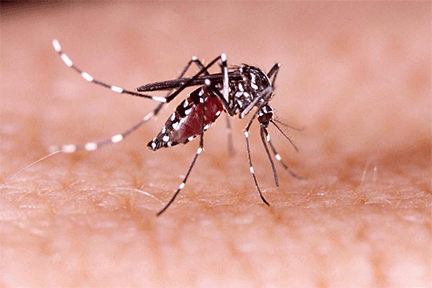Contra Costa County is home to 23 native species of mosquitoes
(photo: Aedes aegypti is an invasive (non-native) mosquito that has been identified in Martinez)
Earlier this month the Contra Costa Mosquito & Vector Control District (District) found a non-native species of mosquito, Aedes aegypti, in a residential area of Martinez, south of Highway 4. This is an invasive species that can transmit the causative agents of Zika, Dengue fever, Chikungunya, and Yellow fever.
What’s the Contra Costa Mosquito & Vector Control District doing about these invasive species of mosquitoes?
District employees are going door-to-door in parts of Martinez to inspect backyard sources for any sign of invasive Aedes aegypti, but frankly, these mosquitoes are very difficult to eliminate. They are good at hiding among vegetation and debris and will lay their eggs in any container that can hold water, even a bottle cap. They are very small, just 1/4 inch, and very stealthy so they can easily remain undetected.
To try to find and eliminate these mosquitoes before they become more widespread in Contra Costa County, District employees are inspecting backyards, taking samples of any mosquitoes present, treating the containers where the mosquitoes are found, and providing residents with important information about invasive species of mosquitoes. County residents’ cooperation with this process is essential as we are working diligently to try to stop these mosquitoes before they spread to other Contra Costa County communities.
What does the term, “invasive mosquito species ” mean?
An invasive mosquito species is a species not native to our area that has been recently introduced and is spreading. Over the last 20 years, three such mosquito species have been introduced to California; Aedes albopictus which is known as the Asian tiger mosquito, Aedes aegypti which ls known as the yellow fever mosquito, and Aedes notoscriptus, the Australian backyard mosquito.
Originally from West Africa, Aedes aegypti have been spreading worldwide and were found in the Southeastern United States before first being detected in Southern California in 2014.
Today, this mosquito can be found from San Diego County to Shasta County and 20 other California counties in between. And as of August 2022, one of those counties is Contra Costa. Earlier this month, District employees identified Aedes aegypti in Martinez, south of Highway 4.
What is the risk of having invasive mosquito species in Contra Costa County?
Aedes aegypti mosquitoes are capable of transmitting Zika virus, Chikungunya virus, and the causative agents of Dengue fever, and Yellow fever. No other mosquito already in Contra Costa County is efficient at transmitting these diseases, so we don’t want mosquitoes that can introduce new diseases to our county. What’s more, Aedes aegypti mosquitoes become infected when they bite an infected person. Currently, no locally acquired cases of Zika or Dengue have been reported in California, although there are several cases reported every year from Californians who have traveled internationally.
The risk of having these invasive mosquitoes in Contra Costa County is that one of them could bite someone who became infected during travel and transmit the virus to other people. There have been reports of ‘local transmission’ in other parts of the US where these mosquitoes occur.
How did these invasive mosquitoes get into Contra Costa County?
That’s a great question. While we don’t know the exact answer, we know how Aedes aegypti travel from community to community. Some people call Aedes aegypti the hitchhiker mosquito because while it does not fly very far on its own, it can lay eggs that stick to containers that a resident moves to a new location. Once those eggs are submerged in water, Aedes aegypti develop from egg to adult in a matter of days, introducing Aedes aegypti to a new area.
What can Contra Costa County residents do to help us get rid of these invasive mosquito species?
The most important thing residents can do to reduce the risk of invasive species is to tip, toss, and, take action:
- Tip over any container holding any amount of standing water and toss out the water. That includes something as small as the amount of water that can collect in a bottle cap.
- Because these mosquitoes lay individual eggs that stick to flower pots and the water dish under the flower pot, buckets, pet bowls, and other types of containers, after you toss out the water, take action by scrubbing the inside of the container to remove any mosquito eggs.
- Provide access to your backyard to District employees who are going door-to-door in search of signs of invasive mosquitoes
- And report any day-biting mosquitoes to the District by calling 925-685-9301 or online.
By working together, we increase the odds we can stop these dangerous mosquitoes before they spread to more areas of Contra Costa County.
Contra Costa Mosquito & Vector Control District, an independent special district and public health agency, is located at 155 Mason Circle in Concord. Contact the District to report mosquito and vector problems online or at (925) 685-9301.

